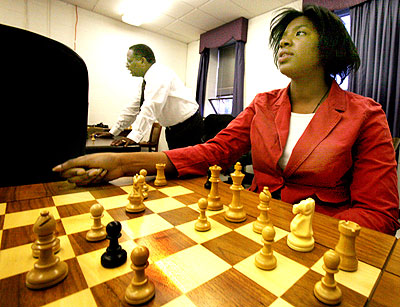
The righthand corner, as we all know, should always be occupied by a light square. But does anybody know how long that has been the case? Since chess took on its current form around five hundred years ago? Before then? After? How long has it been the convention that the righthand corner has been light, and how long has it been part of the offical and accepted Laws of Chess?

13 comments:
More importantly though, why do all manufacturers of chess sets seem to get it wrong?
http://www.freewebs.com/mindanaochess/jaques-chess-50050-board.jpg
http://www.gemstoneking.net/site/lux_img/dia_chess_set.jpg
http://i241.photobucket.com/albums/ff156/CinCin41/chess1.jpg
http://www.congrats.com.au/images/RoyalSelangorChessSet.jpg
Am I the only one who gets really hacked off when he sees chess stuff being advertised by people who can't even be bothered to set the board up properly?!?!
Adam B.
EJH: "The righthand corner, as we all know, should always be occupied by a light square".
I'm wondering, aren't there two righthand corners - one near and one far (with always one of the two occupied by a light square)?
Angus
Heh, I suppose so, but I reckon you'd think of the one on your side as being the righthand corner.
I do have a reason for asking the question, so if anybody knows anybody who might know....
A couple of years ago in Chesham, known for chessy things (Chess Valley, River Chess etc), but no actual chess I went into an antiques/bric-a brac type shop.
There was a chess set there and not only was it correctly set up but it had a theoretical position from the Closed Ruy Lopez circa move 12!
The staff knew nothing about this by the way.
PG
God, for a moment there I wondered if that was me, because I can remember doing precisely that somewhere (I chose the Closed Lopez because I play it, and because you can get quite a long way without taking any pieces off the board).
However, I've not been to Chesham for about thirty years, and thinking about it I may have been using a big outdoor chess set in a pub in Letchworth....
Slightly different topic, but why does the queen start on her own coloured square?
And why has no one told a certain British GM who plays for Wood Green in LL?
http://www.andrewmartinchessacademy.com/images/nick_pert_1.jpg
There's hope for us all?!
Adam B.
It wasn't you. It was definitely a couple of years ago and it was a wooden board in a shop. The old main line with ...Na5, ...c5, ...Qc7 I think.
PG
I would think that the longest theoretical sequences in which all pieces remain on the board are to be found in the Classical King's Indian - thus these would be ideal for this kind of joke (shop assistants being likely to put captured pieces back on the board.)
Btw, surprisingly often I do actually set up the board wrong, eg switched king and queen, black on the right, that kind of thing. Not sure why.
This is the image Adam refers to above: to be honest it looks all right to me. Am I missing something or is Mr Pert's watch behind the black king making it harder to see and perhaps giving the impression that it's the queen?
If we're looking for idiots who don't notice when the king and queen are transposed, I can fulfill that role personally, as I failed to do so in a recent game in the Benasque Open. (My IM opponent noticed on about move four.)
I do wonder, in retrospect, whether the lady in the top image in the original piece had the board set up perfeftly correctly, but the photo got reversed by somebody else. (Not me, I hasten to add).
Tom - how far can you get in the Clssical King's Indian, do you reckon? It's not abnormal in the Breyer to get into the twenties with everything still on the board.
And still in a theoretical position? I don't know the Classical KID theory at all so can't say for sure. I reckon this sort of sequence . . .
1. d4 Nf6 2. c4 g6 3. Nc3 Bg7 4. e4 d6 5. Nf3 O-O 6. Be2 e5 7. Be3 Nc6 8. d5 Ne7 9. Nd2 Ne8 10. O-O f5 11. f3 f4 12. Bf2 g5 13. b4 h5 14. a4 Nf6 15. a5 g4 16. c5
. . . is plausible, though, which would indicate mid to late teens!
My record (from an internet game at red hot pawn) is reaching move 25 with full material left on the board ...
[White "EddieT"]
[Black "TommyC"]
[Result "0-1"]
[WhiteRating "2154"]
[BlackRating "1667"]
[GameId "2141758"]
1. e4 e5 2. Nf3 Nc6 3. Bb5 a6 4. Bc4 Be7 5. d4 d6 6. d5 Nb8 7. O-O Nf6 8. Nc3 O-O 9. Be3 Nbd7 10. a4 Re8 11. a5 h6 12. h3 Bf8 13. Kh1 g6 14. Re1 Bg7 15. Qd2 Kh7 16. b4 Rf8 17. Kg1 Ng8 18. Qd3 f5 19. Bc1 f4 20. Bb2 g5 21. Bb3 Ne7 22. Ne2 Ng6 23. c4 h5 24. Nh2 Nf6 25. c5 g4 26. hxg4 hxg4 27. Rac1 Bh6 28. Rc3 Nh5 29. f3 g3 30. Nf1 Bh3 31. gxh3 Qd7 32. Nc1 Qxh3 33. cxd6 cxd6 34. Rc7+ Kh8 35. Qe2 Nh4 36. Bd1 g2 37. Nh2 Ng3 38. Nd3 Nxe2+ 39. Bxe2 Rac8
40. Nf2 Qxh2+ 41. Kxh2 Rxc7 42. Rc1 Rxc1 43. Bxc1 Rc8 44. Nd3 Rc3 45. Kg1 Rxd3 46. Bxd3 Nxf3+ 47. Kxg2 Ne1+ 48. Kf1 Nxd3 49. Ba3 f3 50. b5 Bf8 51. bxa6 bxa6 52. Kg1 Kg7 53. Kf1 Kg6 54. Kg1 Kg5 55. Kf1 Kf4, 0-1.
Well, as it happens, today's update on the 1.e4 e5 section of the ChessPublishing site includes a game Timofeev - Azarov from the European Championships at Plovdiv in which the first exchange is made on move 27. It was a Breyer.
Post a Comment